Apple iPad mini with Retina Display: Reviewed
by Anand Lal Shimpi on November 16, 2013 8:00 AM ESTThe SoC
The iPad mini with Retina Display rounds out the three platforms that use Apple’s A7 SoC. Although both the iPad Air and iPhone 5S use the A7, the mini’s implementation is closer in nature to the iPhone. The iPad mini’s SoC has always used the same package-on-package (PoP) assembly as the iPhone, with DRAM stacked on top of the SoC itself (1GB in this case). The benefit is obviously a reduction in board area, the downsides have to do with cost and thermals. That’s the first similarity between the mini’s A7 and the iPhone’s A7.
The second is one of frequencies. While the iPad Air’s A7 runs its two Cyclone CPU cores at up to 1.4GHz, the SoC in the iPad mini and the iPhone 5S runs at up to 1.3GHz. That might sound like a minor difference, but it’s far more pronounced when you look at what happens to frequency when you’re running heavy workloads.
Once again I turn to a fairly heavy CPU workload to plot performance over time. This is a multithreaded workload, slightly modified from what we used in the iPad Air review, designed to make the CPU cores consume max power. The scale is linear and the workload is the same across all devices, so what you’re effectively looking at is a graph of thermally bound CPU performance over time across all three A7 implementations:
Being the largest device (and the only device with a metal heat spreader and no DRAM stacked on top), the iPad Air obviously maintains the highest frequencies for the duration of the test. The iPhone 5S, with a significant reduction in internal volume (and a PoP SoC) reduces its CPU frequencies early on in order to keep skin temperature down and properly manage thermals. The iPad mini with Retina Display falls between the two, with its performance curve more closely following that of the iPhone 5S.
Although the mini has a similar max operating frequency to the iPhone 5S, it is a faster device thanks to it being less thermally constrained. Similarly, the iPad Air can be much faster than its clock speed would otherwise imply. If you’re wondering why Apple has been so focused on building its own SoCs and CPU architectures, this is the reason why. There’s a fixed amount of power you can dissipate in the form of heat in these mobile devices while still maintaining a good user experience. Performance per watt is the gating metric for success in mobile, and shipping high IPC/low frequency dual-core SoCs at 32/28nm is the best optimization available to a company like Apple today.
As you’d expect, our browser based CPU tests show the mini’s A7 performing in between the iPhone 5S and iPad Air. None of these tests are anywhere near as stressful as our thermal test from above, so we don’t see exaggerated differences in performance between the platforms. For most, I suspect you won’t notice a huge performance difference between the mini and Air. Those who are heavier users (e.g. audio mixing, 3D gaming, etc…), there will be a performance difference between the two iPads.
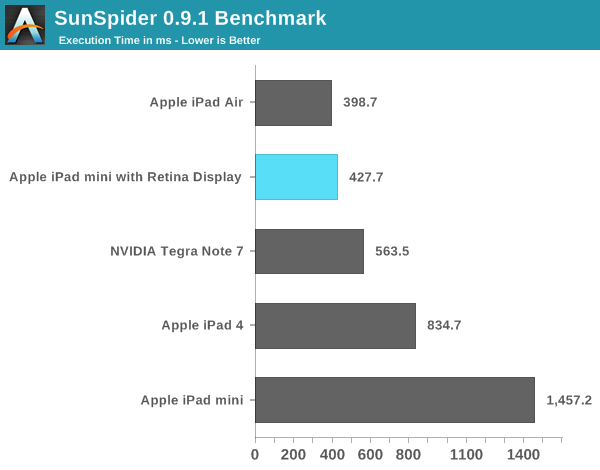

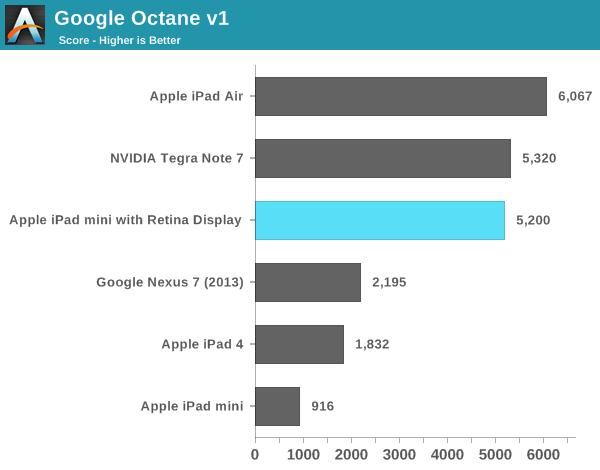
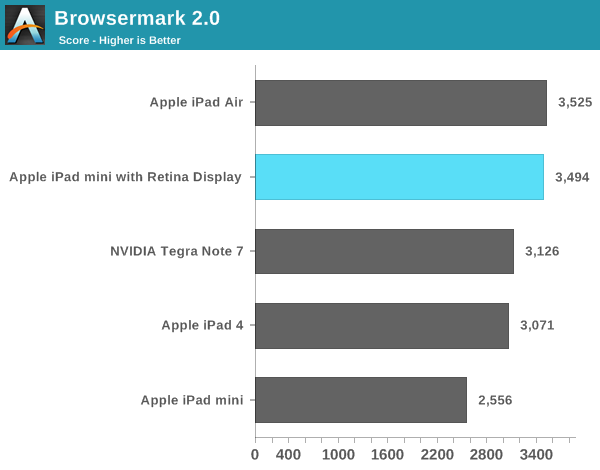
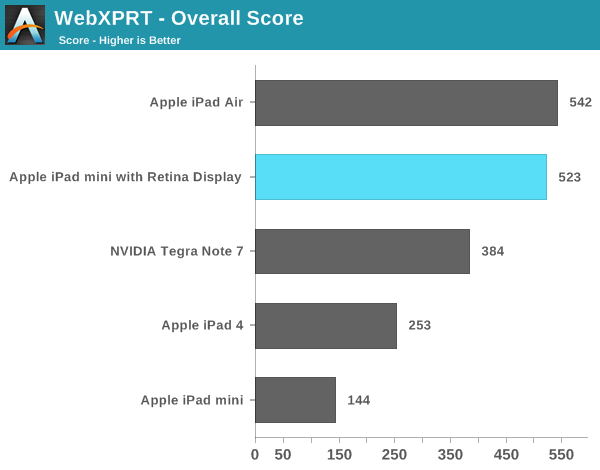
Compared to the first generation iPad mini, the new model is in a completely different performance league. Keep in mind the first mini used Apple’s A5 SoC based on an ARM Cortex A9. That’s the same single threaded performance as what’s in an iPhone 4S, and under iOS 7 it’s clearly running into some performance limits. The new mini with Retina Display however is a completely different animal. It’s fast.
Even comparing to the 4th generation iPad, the new mini is noticeably quicker.
Memory Bandwidth
Looking at the iPad mini’s memory bandwidth curve, we see it tracks very closely with that of the iPhone 5S. This is a slightly modified version of our previous bandwidth test, and you can see peak usable memory bandwidth (from the CPU’s perspective) of around 10GB/s. The ~12GB/s area right before you get out to main memory is bandwidth to the A7’s 4MB system-wide cache that sits after the shared L2 and the memory controller. This cache appears to service CPU, GPU and ISP requests at least.
GPU Performance
I believe the A7’s PowerVR G6430 GPU runs at around 450MHz. This frequency appears unchanged across all three A7 implementations. Once again, the big difference is how much thermal headroom exists in the platform which has an impact on overall performance.
Kishonti’s low level GPU performance tests back up my assertion that GPU frequency is fixed across all A7s. The iPad mini with Retina Display delivers equal performance to the iPad Air. The bigger news here is that nearly all of the GPU bound 3D tests seems to peg the mini and Air as equals. These are some pretty intense tests, but it looks like on the GPU side there’s no significant throttling when running at full tilt.
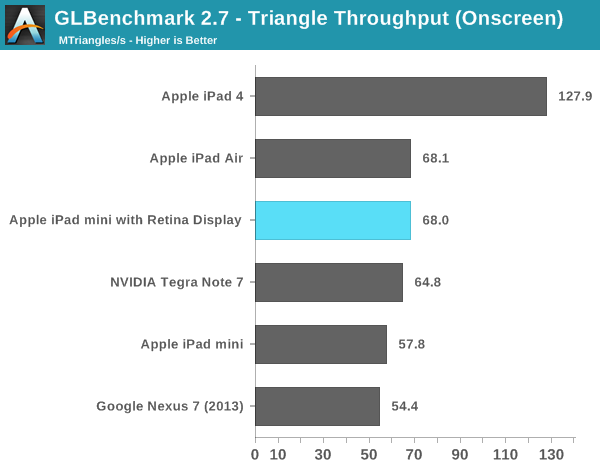

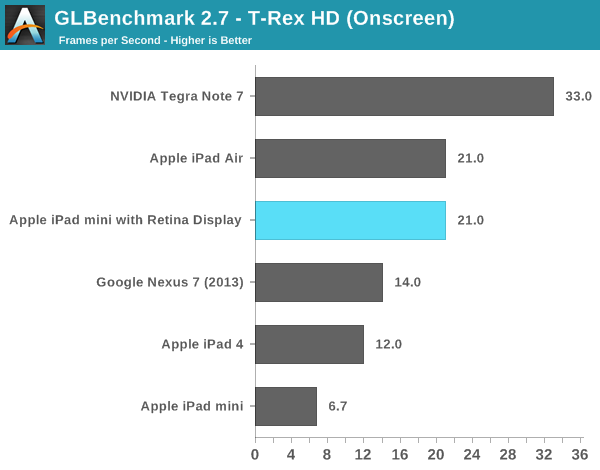

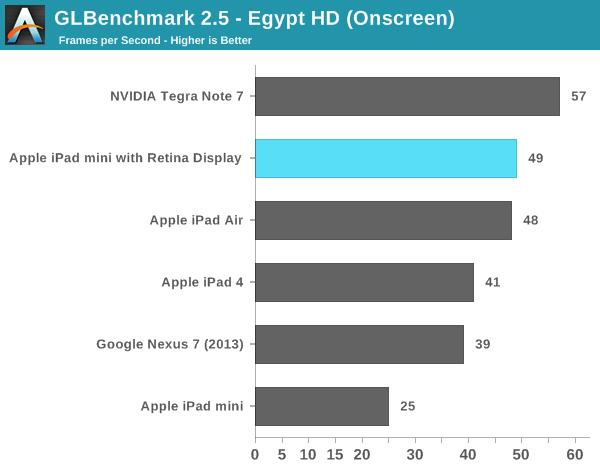
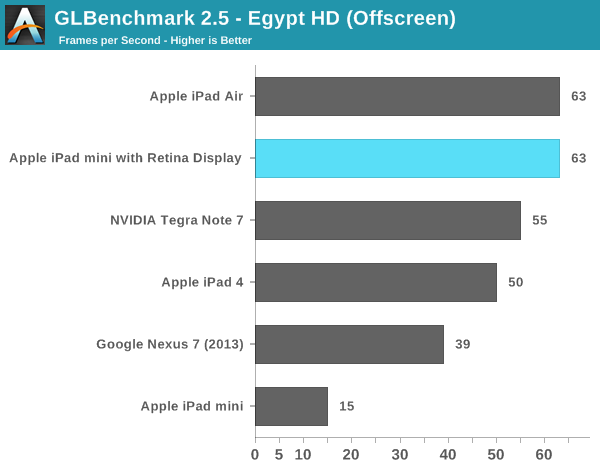
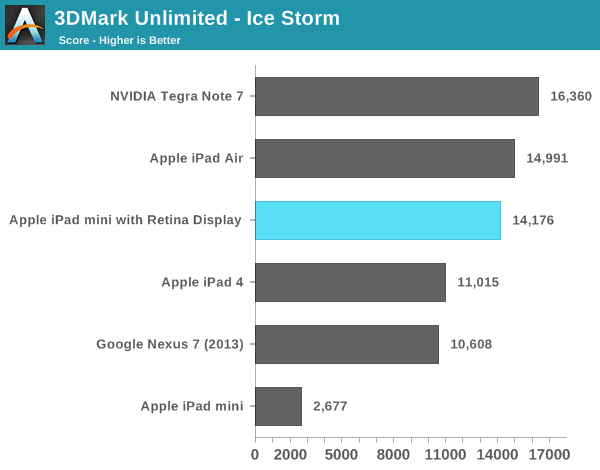
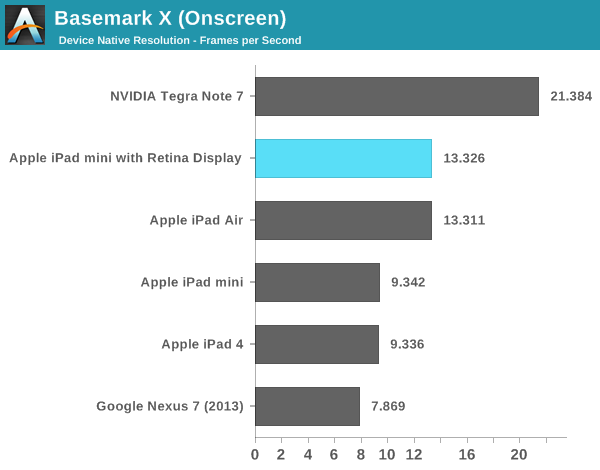
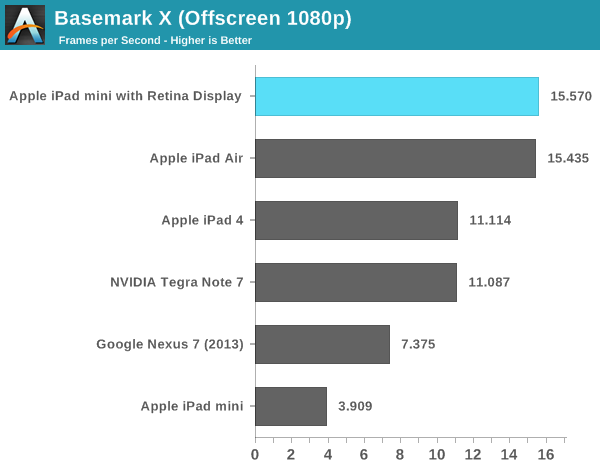
As I mentioned in our iPad Air review, despite having less peak theoretical memory bandwidth than the A5X/A6X, the A7 in the iPad mini never seems to regress in performance compared to even the iPad 4. Across the board the mini appears to be faster, more responsive and have more performance on tap than any prior iPad (big or small). The comparison to the original iPad mini is of course night and day. Even looking at lighter tests like the old GLBench Egypt HD benchmark, the iPad mini with Retina Display manages to be nearly twice as fast as the original mini - all while rendering 4x the number of pixels.


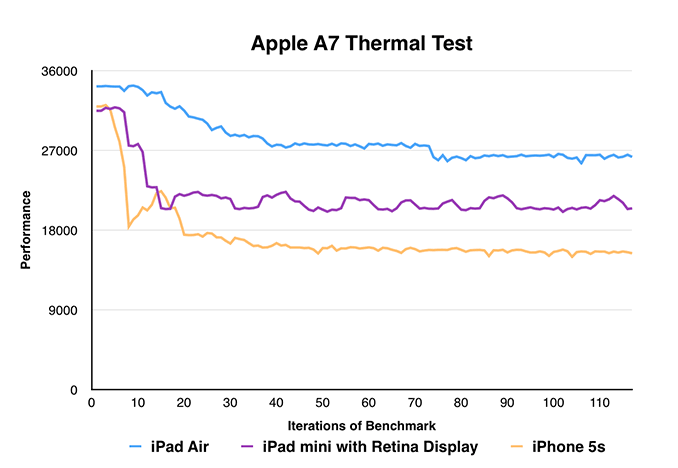
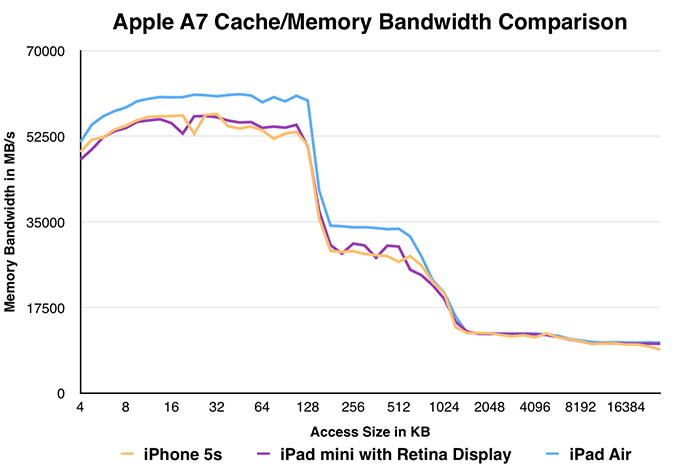








345 Comments
View All Comments
akdj - Sunday, November 17, 2013 - link
Sirfergy....YOU were the 'one' that actually bought the Dell. I was wondering...because they sure ain't selling! Lol...that isn't an 'amazing' tablet by any stretch. It's cheaply made, feels like it's cheaply made, lacks any sort of Eco system or app development community, and 16:10 couldn't be a worse format for using in portrait, reading a book, surfing, etc. Anand's comments to wrap it up, mentioning both the Nex7 and the HDx in the article are excellent recommendations if iOS isn't your thing. That Dell is a bad joke. If Windows is hour thing, last year's Surface at a $150 discount (299-349) is a significantly better buy...or, if you can swing the $500, the Surface 2 is a significantly better option that that silly Dell that definitely does NOT boast a 'Full PC plus excellent experience'.One other cool thing about the iOS devices, they maintain their value. Like their lap and desktop counterparts, if you decide to upgrade each year, you'll typically recoup 70-80% of the original value. Keep it for two years, you'll grab 50-60/70% of that original purchase price. Try 'giving' away a two year old Dell Windows tablet. You're certainly not going to 'sell' it or recoup any of that original outlay
J
ws3 - Saturday, November 16, 2013 - link
or because they don't want a Windows 8.1 tablet.Puberticus - Saturday, November 16, 2013 - link
Who cares about the hardware. I'm only concerned about the ecosystem. Win has none. They have to bribe developers to come up with anything.Cptn_Slo - Sunday, November 17, 2013 - link
Why you don't want Win8 tabletsOS more suited for desktop
Few useful metro apps
Slower than android/ios on same hardware
Screen is shit for same price
OS takes up more space
Thicker with less battery life @ same price
Viruses
teng029 - Sunday, November 17, 2013 - link
One should choose anything they purchase based on need. A cheaper tablet doesn't make a better tablet. There are other differences to consider such as the ecosystem. When you buy a car, do you buy the cheapest or do you buy the one that fits your needs?zeagus - Monday, November 18, 2013 - link
Or, you know, preference for the iOS experience on a tablet.RadarTheKat - Monday, November 18, 2013 - link
Or prior experience with Windows, and Microsoft in general. LOL!socio-statistical - Monday, November 18, 2013 - link
Or, maybe they want to run actual tablet software on a tablet, and not have to use it like a laptop.doobydoo - Monday, November 18, 2013 - link
Firstly - because the Nexus 7 is pretty much the ONLY alternative that anyone who had done any research would consider, he arguably IS addressing every option.But secondly, and most importantly, did you miss the very first line in the comment to which you replied, in which he argues that asking Anand to address every single possibility is stupid?
jameskatt - Saturday, November 16, 2013 - link
If you can't afford an Apple product, you simply aren't a target Apple customer.If you care about quality - like the Chinese who make 3% of the world's population but buy 30% of the world's luxury goods - then you buy the iPad mini or iPad air.
When you love luxury cars, you simply don't buy a Hyundai or Chevy. You buy Mercedes Benz or BMW. If you want to economize, you at least buy a Lexus.